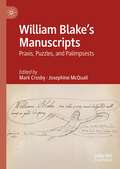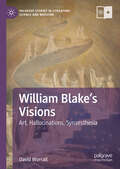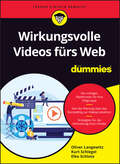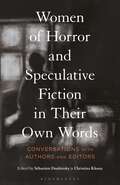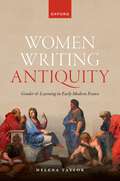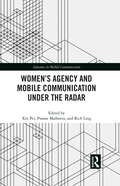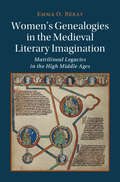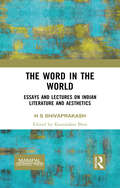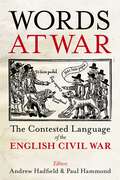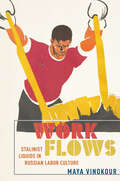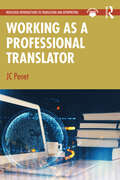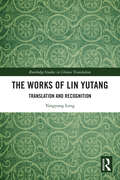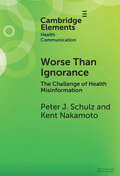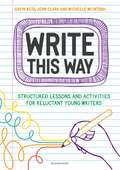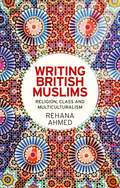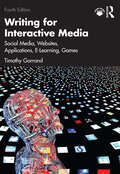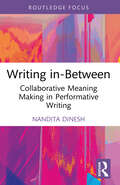- Table View
- List View
William Blake's Manuscripts: Praxis, Puzzles, and Palimpsests
by Mark Crosby Josephine A. McQuailThis collection of essays examines how close analysis of William Blake’s manuscripts can yield new discoveries about his techniques, his working habits, and his influences. With the introduction of facsimile editions and more particularly, the William Blake Archive, the largest digital repository of Blake materials online, scholars have been able to access Blake’s work in as close its original medium, leading to important insights into Blake’s creative process and mythopoetic system. Recent advancements in digital editing and reproduction has further increased interest in Blake’s manuscripts. This volume brings together both established Blake scholars, including G.E. Bentley Jnr’s final essay on Blake, and upcoming scholars whose research is at the intersection of digital humanities, critical theory, textual scholarship, queer theory, transgender studies, reception history, and bibliographical studies. The chapters seek to cover the breadth of Blake’s manuscripts: poetry, letters, notebook entries, and annotations. Together, these chapters offer an overview of the current state of research in Blake studies on manuscripts at a point when his manuscripts have become increasingly available in digital environments, and gesture to a possible future of Blake scholarship in general.
William Blake's Visions: Art, Hallucinations, Synaesthesia (Palgrave Studies in Literature, Science and Medicine)
by David WorrallThis book is an inquiry into whether what Blake called his ‘visions’ can be attributed to recognizable perceptual phenomena. The conditions identified include visual hallucinations (some derived from migraine aura), and auditory and visual hallucinations derived from several types of synaesthesia. Over a long period of time, Blake has been celebrated as a ‘visionary,’ yet his ‘visions’ have not been discussed. Worrall draws on an understanding of neuroscience to examine both Blake’s visual art and writings, and discusses the lack of evidence pointing towards psychosis or pathological ill-health, thus questioning the rumours pertaining to Blake’s insanity.
Wirkungsvolle Videos fürs Web für Dummies (Für Dummies)
by Oliver Langewitz Kurt Schlegel Elke SchloteMithilfe von Videos das Netz begeistern Videos bieten Ihnen die Möglichkeit, eigene Ideen zu vermitteln oder Ihre Marke zu präsentieren. Wie Sie wirkungsvolle Videos fürs Web erstellen und was Sie bei der videobasierten Kommunikation beachten müssen, erfahren Sie in diesem Buch. Oliver Langewitz, Kurt Schlegel und Elke Schlote erklären Ihnen in praktischen Schritten, wie Ihnen die Planung, Erstellung und Verbreitung von Videos fürs Web optimal gelingt. Dabei lernen Sie auch die Besonderheiten der verschiedenen Internetplattformen kennen und wie Sie Ihre Zielgruppe mit Ihren Inhalten abholen. Sie erfahren Wie Sie professionelle Webvideos produzieren Wie Sie in Ihren Videos wirksame Geschichten erzählen Welche Online-Kanäle für Ihre Videos wichtig sind Wie es Ihnen gelingt, mit Ihren Videos eine breite Community zu erreichen
Women of Horror and Speculative Fiction in Their Own Words: Conversations with Authors and Editors
by Sébastien Doubinsky and Christina KkonaWhat makes science fiction genres better than others at challenging social conventions, especially gender? Are speculative works structured differently when addressed to traditionally under-portrayed individuals or communities?This collection of interviews elicits truly honest and thought-provoking responses that focus on the biographical dimension in speculative fiction, questions of intersectionality, genre (re)definitions and the politicization of fiction. It gives voice to women of different races, nations, classes and sexual orientations who write and edit speculative fiction – such as Ellen Datlow, Kathe Koja, Angela Mi Young Hur, Eugen Bacon, and Cat Rambo. The interviews clarify how the junction of genre and gender is a key element to understanding this literary field, while simultaneously contextualizing and theorizing the interview itself, as a literary genre and a research tool.
Women Writing Antiquity: Gender and Learning in Early Modern France
by Helena TaylorWomen Writing Antiquity argues that the struggle to define the female intellectual in seventeenth-century France lay at the centre of a broader struggle over the definition of literature and literary knowledge during a time of significant cultural change. As the female intellectual became a figure of debate, France was also undergoing a shift away from the dominance of classical cultural models, the transition towards a standardized modern language, the development of a national literature and literary canon, and the emergence of the literary field. This book explores the intersection of these phenomena, analyzing how a range of women constructed the female intellectual through their reception of Greco-Roman culture. Women Writing Antiquity offers readings of known and less familiar works from a diverse corpus of translators, novelists, poets, linguists, playwrights, essayists, and fairy tale writers, including Marie de Gournay, Madeleine de Scud?ry, Madame de Villedieu, Antoinette Deshouli?res, Marie-Jeanne L'H?ritier, and Anne Dacier. Challenging traditionally formalist and source-text orientated approaches, the study reframes classical reception in terms of authorial self-fashioning and professional strategy, and explores the symbolic value of Latin literacy to an author's projected identity. These writers used reception of Greco-Roman culture to negotiate the value attributed to different genres, the nature of poetics, the legitimacy of varied modes of authorship, the qualities and properties of French, and even how and by whom these topics might be debated. Women Writing Antiquity combines a new take on the literary history of the period with a retelling of the history of the figure of the 'learned woman'.
Women’s Agency and Mobile Communication Under the Radar (Advances in Mobile Communication)
by Xin Pei Pranav Malhotra Rich LingThis volume maps the role of mobile communication in the daily lives of women around the globe, shedding light on “under-the-radar” use of mobile communication to display a nuanced understanding of social impacts that may affect the gender construction processes of women at the individual, institutional, and societal levels. A global team of authors focus on the use of mobile communication by women in the lower rungs of their respective societies, as well as those who migrate with marginalized statuses within and across the national borders, to demonstrate how “under-the-radar” use of mobile communication is deeply inscribed within diversified social, cultural, historical, and political milieus. Illuminating the social structural constraints faced by women under their dynamic negotiation of agentic mobile phone use for self-empowerment, the chapters cover women’s economic activities, health care, well-being, migration, gendered identity, and the practices of different gender roles. This comprehensive and interdisciplinary volume will be of interest to scholars and students of media and communication, new and digital media, mobile communication, gender studies, sociology, anthropology, political science, and cultural studies.
Women’s Agency and Mobile Communication Under the Radar (Advances in Mobile Communication)
by Xin Pei Pranav Malhotra Rich LingThis volume maps the role of mobile communication in the daily lives of women around the globe, shedding light on “under-the-radar” use of mobile communication to display a nuanced understanding of social impacts that may affect the gender construction processes of women at the individual, institutional, and societal levels. A global team of authors focus on the use of mobile communication by women in the lower rungs of their respective societies, as well as those who migrate with marginalized statuses within and across the national borders, to demonstrate how “under-the-radar” use of mobile communication is deeply inscribed within diversified social, cultural, historical, and political milieus. Illuminating the social structural constraints faced by women under their dynamic negotiation of agentic mobile phone use for self-empowerment, the chapters cover women’s economic activities, health care, well-being, migration, gendered identity, and the practices of different gender roles. This comprehensive and interdisciplinary volume will be of interest to scholars and students of media and communication, new and digital media, mobile communication, gender studies, sociology, anthropology, political science, and cultural studies.
Women's Genealogies in the Medieval Literary Imagination: Matrilineal Legacies in the High Middle Ages (Cambridge Studies in Medieval Literature)
by null Emma O. BératUncovering the many striking female alternatives to patrilineal narratives in medieval texts, Emma O. Bérat explores strategies of writing and illustration that creatively and purposefully depict women's legacies. Genealogy, used to justify a character's present power and project it onto the future, was crucial to medieval political, literary, and historical thought. While patrilineage often limited women to exceptional or passive roles, other genealogical forms that represent and promote women's claims are widespread in medieval texts. Female characters transmit power through book patronage and reading, enduring landmarks, and international travel, as well as childbearing and succession. These flexible – if messy – genealogies reflect the web of political, biological, and spiritual relations that frequently characterized elite women's lives. Examining hagiography, chronicles, genealogical rolls, and French, English, and Latin romances, as well as associated codices and images, Bérat highlights the centrality of female characters and historical women to this fundamental aspect of medieval consciousness.
The Word in the World: Essays and Lectures on Indian Literature and Aesthetics
by H S ShivaprakashThe Word in the World is a collection of essays and lectures by H S Shivaprakash, a well-known poet, playwright, and translator. Edited by Kamalakar Bhat, this book brings together Prof Shivaprakash’s interventions in the realm of issues that are entwined with the continuities and discontinuities in the cultural negotiations of India. Distinctively, these are essays on subjects ranging from the nature and significance of medieval works of literature in India to issues arising out of developments in Indian aesthetics. The unfeigned magnitude of this work must be found among students and scholars, who will gain from it a perspective significantly different from the ones available in the prevailing academic discourses, thus indicating a way beyond poststructuralist/postmodernist frameworks. This is a book that will interest a wide variety of readers with its engaging insights and breadth of reference especially because it is written in a comprehensible style. Print edition not for sale in South Asia (India, Sri Lanka, Nepal, Bangladesh, Pakistan and Bhutan)
The Word in the World: Essays and Lectures on Indian Literature and Aesthetics
by H S ShivaprakashThe Word in the World is a collection of essays and lectures by H S Shivaprakash, a well-known poet, playwright, and translator. Edited by Kamalakar Bhat, this book brings together Prof Shivaprakash’s interventions in the realm of issues that are entwined with the continuities and discontinuities in the cultural negotiations of India. Distinctively, these are essays on subjects ranging from the nature and significance of medieval works of literature in India to issues arising out of developments in Indian aesthetics. The unfeigned magnitude of this work must be found among students and scholars, who will gain from it a perspective significantly different from the ones available in the prevailing academic discourses, thus indicating a way beyond poststructuralist/postmodernist frameworks. This is a book that will interest a wide variety of readers with its engaging insights and breadth of reference especially because it is written in a comprehensible style. Print edition not for sale in South Asia (India, Sri Lanka, Nepal, Bangladesh, Pakistan and Bhutan)
Words at War: The Contested Language of the English Civil War (Proceedings of the British Academy #261)
by ANDREW HADFIELD AND PAUL HAMMONDThe English Civil War was not simply a conflict between two opposing, unstable, complicated alliances of various factions, but a war of words. Supporters of the King and allies of Parliament and the New Model Army clashed over ideals, ideas, and concepts as they each sought to impose their understanding of history and visions of the future, realizing that victory could only be secured by establishing a political and cultural language that would guide and direct those who used it. Accordingly, the Civil War witnessed vociferous arguments over many key English words central to life and thought in the seventeenth century, and often up to the present day. Words at War seeks to bring together scholars of literature, history, religion, and philosophy to analyse the ways in which key terms were deployed and debated in the Civil War and Commonwealth. In doing so it refocuses attention on ideas and concepts that shaped the modern world well beyond the bloody conflict on the battlefield.
Work Flows: Stalinist Liquids in Russian Labor Culture (NIU Series in Slavic, East European, and Eurasian Studies)
by Maya VinokourWork Flows investigates the emergence of "flow" as a crucial metaphor within Russian labor culture since 1870. Maya Vinokour frames concern with fluid channeling as immanent to vertical power structures—whether that verticality derives from the state, as in Stalin's Soviet Union and present-day Russia, or from the proliferation of corporate monopolies, as in the contemporary Anglo-American West. Originating in pre-revolutionary bio-utopianism, the Russian rhetoric of liquids and flow reached an apotheosis during Stalin's First Five-Year Plan and re-emerged in post-Soviet "managed democracy" and Western neoliberalism.The literary, philosophical, and official texts that Work Flows examines give voice to the Stalinist ambition of reforging not merely individual bodies, but space and time themselves. By mobilizing the understudied thematic of fluidity, Vinokour offers insight into the nexus of philosophy, literature, and science that underpinned Stalinism and remains influential today. Work Flows demonstrates that Stalinism is not a historical phenomenon restricted to the period 1922-1953, but a symptom of modernity as it emerged in the twentieth century. Stalinism's legacy extends far beyond the bounds of the former Soviet Union, emerging in seemingly disparate settings like post-Soviet Russia and Silicon Valley.
The Work Smarter Guide to Presenting: An Insider's Guide to Making Your Presentations Perfect (Work Smarter Series)
by Louisa ClarkeFact: most people would rather die than present in public. According to the National Institute of Mental Health, 75% of people rank fear of speaking in public as their number-one fear. In second place: death. For many people, presenting arouses fear of failure, of forgetting their content, of appearing nervous, of being ignored or judged by their audience, of encountering the unexpected, of technology, of going on too long or drying up. And too many presentations are lifeless, pointless and go on far too long. Yet the ability to stand up and give a presentation, a speech, a lesson or a toast in a way that captures your audience's attention and actually makes them think, feel or do something as a result is one of the most effective ways to stand out at work and in life. This book is a shortcut to making you shine on stage when you are under the spotlight or presenting on screen. It is a supremely practical guide to giving presentations that will take away the fear factor by providing the tips, techniques and tools to create and deliver presentations you'll enjoy giving and your audience will want to hear. Think of it as a friendly and experienced coach who can help you focus on the things that really make the difference in presenting so you can project the real you to the world in a way that feels comfortable and smart.The Work Smarter series:Our books provide shortcuts, tips and life-hacks for the development of essential business skills. The books bring together accomplished industry experts who have learned their trades at the coalface. They teach the skills ambitious businesspeople need in order to tip the playing field in their favour. It is the pirate equivalent of business advice; the antidote to conventional wisdom; 'smarter' practice over 'best practice'.
Working as a Professional Translator (Routledge Introductions to Translation and Interpreting)
by JC PenetWhat does it take to be a professional translator in the 21st century? What are the opportunities and challenges of a career in translation? How do you find that first job? How do you ensure that work remains sustainable over time? Combining industry insights, the latest research in the field of translation studies and a career coaching approach, this textbook takes aspiring translators on an explorative journey that helps them answer these questions for themselves so they can become the professional translators they aspire to be.Each chapter of this hands-on guide opens with key questions that budding translators might typically ask themselves and encourages them to reflect on their relevance for their own situation through regular discussion points and ‘Topics for discussion and assignments’. Targeted suggestions for further reading at the end of each chapter guide users in deepening their knowledge. Written primarily for students on translation courses, the accessible language, tone and design of this book will appeal to anyone who is thinking of embarking upon a career in translation. Additional resources are available on the Routledge Translation Studies Portal.
Working as a Professional Translator (Routledge Introductions to Translation and Interpreting)
by JC PenetWhat does it take to be a professional translator in the 21st century? What are the opportunities and challenges of a career in translation? How do you find that first job? How do you ensure that work remains sustainable over time? Combining industry insights, the latest research in the field of translation studies and a career coaching approach, this textbook takes aspiring translators on an explorative journey that helps them answer these questions for themselves so they can become the professional translators they aspire to be.Each chapter of this hands-on guide opens with key questions that budding translators might typically ask themselves and encourages them to reflect on their relevance for their own situation through regular discussion points and ‘Topics for discussion and assignments’. Targeted suggestions for further reading at the end of each chapter guide users in deepening their knowledge. Written primarily for students on translation courses, the accessible language, tone and design of this book will appeal to anyone who is thinking of embarking upon a career in translation. Additional resources are available on the Routledge Translation Studies Portal.
The Works of Lin Yutang: Translation and Recognition (Routledge Studies in Chinese Translation)
by Yangyang LongThe Works of Lin Yutang is the first book to provide a comprehensive study of Lin Yutang’s translation theory and translated (and written) works in English as a whole, examined from the perspective of his pursuit of recognition of cultural equity between China and the English-speaking world. The arc of the book is Lin’s new method of translating China to the Anglophone world, which is crucial to rendering Chinese culture as an equal member of the modern world. This book identifies Lin’s legacy of translation and recognition as his acknowledgement of source and target cultural territories in translation, and at the same time, his questioning of perspectives that privilege the authority of either. This book will appeal to scholars and students in Translation Studies, World and Comparative Literature, Literary and Cultural Studies, and Chinese Studies. It can also be used as a reference work for practitioners in translation and creative writing.
The Works of Lin Yutang: Translation and Recognition (Routledge Studies in Chinese Translation)
by Yangyang LongThe Works of Lin Yutang is the first book to provide a comprehensive study of Lin Yutang’s translation theory and translated (and written) works in English as a whole, examined from the perspective of his pursuit of recognition of cultural equity between China and the English-speaking world. The arc of the book is Lin’s new method of translating China to the Anglophone world, which is crucial to rendering Chinese culture as an equal member of the modern world. This book identifies Lin’s legacy of translation and recognition as his acknowledgement of source and target cultural territories in translation, and at the same time, his questioning of perspectives that privilege the authority of either. This book will appeal to scholars and students in Translation Studies, World and Comparative Literature, Literary and Cultural Studies, and Chinese Studies. It can also be used as a reference work for practitioners in translation and creative writing.
World Construction via Networking: The Storytelling Mechanics of the Marvel Cinematic Universe (Lettre)
by Christopher Joseph HansenWith the mainstream's growing acceptance of worlds and storytelling spread among several different texts - e.g., films, television series, novels, and comics - this pioneering study employs a multidisciplinary approach combining transmediality, network theory, and narratology to analyze the narrative network of the Marvel Cinematic Universe. In this analysis, Christopher Hansen thoroughly examines storytelling techniques while providing a fresh theoretical framework to develop a structural model for interconnected narratives. He redefines our understanding of narrative dynamics in one of the most successful cinematic franchises of all time.
Worse Than Ignorance: The Challenge of Health Misinformation (Elements in Health Communication)
by null Peter J. Schulz null Kent NakamotoThis Element considers health misinformation and the problems it presents. The evolving communication context—changing doctor-patient relationships and developments in information technology—presents patients with a vastly enriched information landscape and new challenges to patients navigating it. These challenges are magnified as growing patient empowerment and autonomy have increased expectations for patient involvement in medical decisions. In this context, the ways people approach presented information, learn from it, understand it, and use it, exacerbate the risk that they become misinformed—believing things that are inimical to improved health. Moreover, these same processes make it difficult to correct such beliefs. Approaches building on trust between patient and professional exemplify improved communication to increase accurate patient knowledge and understanding in the service of better health. This title is also available as Open Access on Cambridge Core.
Write This Way: Structured lessons and activities for reluctant young writers
by Dr. Gavin Reid Jenn Clark Michelle McIntoshMany children avoid writing for a number of reasons – perhaps they find it tedious or frustrating, or perhaps they have dyslexia or dysgraphia. This structured programme of writing activities and lessons makes writing engaging and accessible for reluctant writers, by encouraging primary teachers and learners to work together to develop children's writing skills.The book covers all aspects of primary school writing, including grammar, sentence development, punctuation, paragraph writing and planning. It also shows teachers how to develop self-sufficiency skills in writing and encourage learner independence. Each section in the book builds on previous skills learned, from word level up to creative writing skills, providing pupils with a complete range of writing tools. The ready-to-use resources for each topic - including mini lessons, discovery tools and activities - offer extensions and adaptations to suit all pupil needs, including fun ideas for multisensory learning, group interventions or to keep pupils learning outside of the classroom.For school staff working with children who find writing challenging, this practical toolkit provides a range of activities based on solid research and hands-on experience that can be incorporated straight into lessons and teaching practices.
Writing British Muslims: Religion, class and multiculturalism
by Rehana AhmedThe Rushdie affair, September 11 2001 and 7/7 pushed British Muslims into the forefront of increasingly fraught debate about multiculturalism. Stereotyping images have proliferated, reducing a heterogeneous minority group to a series of media soundbites.This book examines contemporary literary representations of Muslims by British writers of South Asian Muslim descent – including Salman Rushdie, Hanif Kureishi, Monica Ali and Nadeem Aslam – to explore the contribution they make to urgent questions about multicultural politics and the place of Muslims within Britain. By focusing on class, and its intersection with faith, ‘race’ and gender in identity- and community-formation, it challenges the dichotomy of secular freedom versus religious oppression that constrains thinking about British Muslims, and offers a more nuanced perspective on multicultural debates and controversies.Writing British Muslims will appeal to academics and postgraduate and final-year undergraduate students in the fields of postcolonial studies, English studies and cultural studies.
Writing for Interactive Media: Social Media, Websites, Applications, e-Learning, Games
by Timothy GarrandThis thoroughly revised fourth edition teaches students and professionals how to create interactive content for all types of new media and become successful writers or designers in a variety of fields.This comprehensive guide is grounded in the core principles and skills of interactive media writing, in which writers create text and structure content to guide users through interactive products such as websites or software. The book examines case studies on interactive formats including complex informational websites, computer games, e-learning courses, training programs, and immersive exhibits. These case studies assess real-world products and documentation used by professional writers such as scripts, outlines, screenshots, and flowcharts. The book also provides practical advice on how to use interactive media writing skills to advance careers in the social media, technical, instructional communication, and creative media fields. This edition includes new chapters on UX Writing and Content Design, Social Media Writing, and Writing for Mobile.Writing for Interactive Media prepares students for the writing challenges of today’s technology and media. It can be used as a core textbook for courses in UX Writing, Writing for Digital Media, and Technical and Professional Communication and is a valuable resource for writing professionals at all levels.Supplemental resources include a sample syllabus, class assignments, student exercises, scripts, outlines, flowcharts, and other interactive writing samples. They are available online at www.routledge.com/9781032554242
Writing for Interactive Media: Social Media, Websites, Applications, e-Learning, Games
by Timothy GarrandThis thoroughly revised fourth edition teaches students and professionals how to create interactive content for all types of new media and become successful writers or designers in a variety of fields.This comprehensive guide is grounded in the core principles and skills of interactive media writing, in which writers create text and structure content to guide users through interactive products such as websites or software. The book examines case studies on interactive formats including complex informational websites, computer games, e-learning courses, training programs, and immersive exhibits. These case studies assess real-world products and documentation used by professional writers such as scripts, outlines, screenshots, and flowcharts. The book also provides practical advice on how to use interactive media writing skills to advance careers in the social media, technical, instructional communication, and creative media fields. This edition includes new chapters on UX Writing and Content Design, Social Media Writing, and Writing for Mobile.Writing for Interactive Media prepares students for the writing challenges of today’s technology and media. It can be used as a core textbook for courses in UX Writing, Writing for Digital Media, and Technical and Professional Communication and is a valuable resource for writing professionals at all levels.Supplemental resources include a sample syllabus, class assignments, student exercises, scripts, outlines, flowcharts, and other interactive writing samples. They are available online at www.routledge.com/9781032554242
Writing in-Between: Collaborative Meaning Making in Performative Writing (Routledge Focus on Literature)
by Nandita DineshWriting in-Between lies at intersections: between theory and praxis; between fiction and non-fiction; between author and reader; between the personal and the political. Beginning with a conceptual glossary that prepares readers for their journey through the book, Dinesh offers two central texts to invite readers to become co-creators. The first, F for _____, is written as an “academic novella” and culminates with an interactive section that is composed of guided invitations for the reader/co-creator. The second text, Julys, takes the form of a “dramatic memoir” and intersperses invitations for readers/co-creators between each of its chapters. Dinesh brings these threads together in an entirely interactive concluding chapter, where her hopes for collaborative meaning making take centre stage. In all of its unique invitations to engage, Dinesh’s readers/co-creators can either choose to craft their creations in personal notebooks or blank spaces in this work’s physical copy, or to engage more publicly via virtual forums that can be accessed via QR codes and accompanying links that are scattered throughout the book. Guided by questions about writing can “do” — questions that have shaped Dinesh’s work as an artist, scholar, and educator for almost two decades — Writing in Between embodies one central tenet: that the significance of performative writing might be most powerfully experienced through a collaborative process of meaning making between a text’s author and its readers turned co-creators.
Writing in-Between: Collaborative Meaning Making in Performative Writing (Routledge Focus on Literature)
by Nandita DineshWriting in-Between lies at intersections: between theory and praxis; between fiction and non-fiction; between author and reader; between the personal and the political. Beginning with a conceptual glossary that prepares readers for their journey through the book, Dinesh offers two central texts to invite readers to become co-creators. The first, F for _____, is written as an “academic novella” and culminates with an interactive section that is composed of guided invitations for the reader/co-creator. The second text, Julys, takes the form of a “dramatic memoir” and intersperses invitations for readers/co-creators between each of its chapters. Dinesh brings these threads together in an entirely interactive concluding chapter, where her hopes for collaborative meaning making take centre stage. In all of its unique invitations to engage, Dinesh’s readers/co-creators can either choose to craft their creations in personal notebooks or blank spaces in this work’s physical copy, or to engage more publicly via virtual forums that can be accessed via QR codes and accompanying links that are scattered throughout the book. Guided by questions about writing can “do” — questions that have shaped Dinesh’s work as an artist, scholar, and educator for almost two decades — Writing in Between embodies one central tenet: that the significance of performative writing might be most powerfully experienced through a collaborative process of meaning making between a text’s author and its readers turned co-creators.
